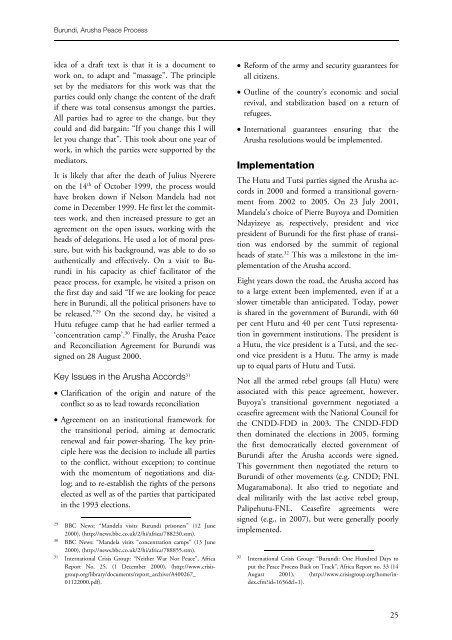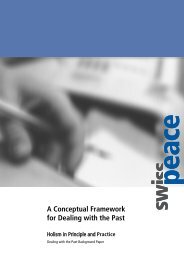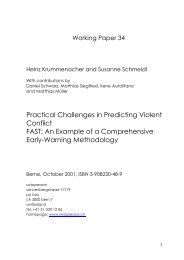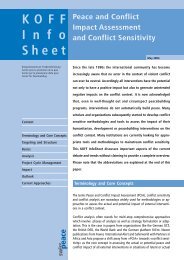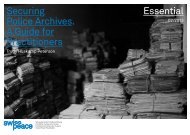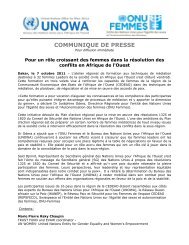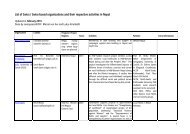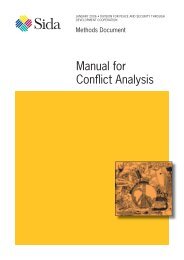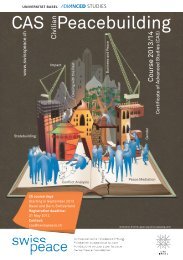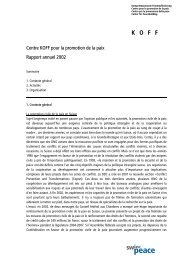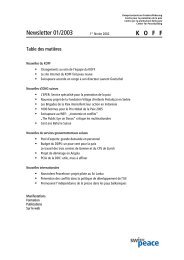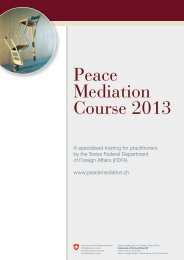Unpacking the Mystery of Mediation in African Peace ... - Swisspeace
Unpacking the Mystery of Mediation in African Peace ... - Swisspeace
Unpacking the Mystery of Mediation in African Peace ... - Swisspeace
Create successful ePaper yourself
Turn your PDF publications into a flip-book with our unique Google optimized e-Paper software.
Burundi, Arusha <strong>Peace</strong> Process<br />
idea <strong>of</strong> a draft text is that it is a document to<br />
work on, to adapt and “massage”. The pr<strong>in</strong>ciple<br />
set by <strong>the</strong> mediators for this work was that <strong>the</strong><br />
parties could only change <strong>the</strong> content <strong>of</strong> <strong>the</strong> draft<br />
if <strong>the</strong>re was total consensus amongst <strong>the</strong> parties.<br />
All parties had to agree to <strong>the</strong> change, but <strong>the</strong>y<br />
could and did barga<strong>in</strong>: “If you change this I will<br />
let you change that”. This took about one year <strong>of</strong><br />
work, <strong>in</strong> which <strong>the</strong> parties were supported by <strong>the</strong><br />
mediators.<br />
It is likely that after <strong>the</strong> death <strong>of</strong> Julius Nyerere<br />
on <strong>the</strong> 14 th <strong>of</strong> October 1999, <strong>the</strong> process would<br />
have broken down if Nelson Mandela had not<br />
come <strong>in</strong> December 1999. He first let <strong>the</strong> committees<br />
work, and <strong>the</strong>n <strong>in</strong>creased pressure to get an<br />
agreement on <strong>the</strong> open issues, work<strong>in</strong>g with <strong>the</strong><br />
heads <strong>of</strong> delegations. He used a lot <strong>of</strong> moral pressure,<br />
but with his background, was able to do so<br />
au<strong>the</strong>ntically and effectively. On a visit to Burundi<br />
<strong>in</strong> his capacity as chief facilitator <strong>of</strong> <strong>the</strong><br />
peace process, for example, he visited a prison on<br />
<strong>the</strong> first day and said “If we are look<strong>in</strong>g for peace<br />
here <strong>in</strong> Burundi, all <strong>the</strong> political prisoners have to<br />
be released.” 29 On <strong>the</strong> second day, he visited a<br />
Hutu refugee camp that he had earlier termed a<br />
‘concentration camp’. 30 F<strong>in</strong>ally, <strong>the</strong> Arusha <strong>Peace</strong><br />
and Reconciliation Agreement for Burundi was<br />
signed on 28 August 2000.<br />
Key Issues <strong>in</strong> <strong>the</strong> Arusha Accords 31<br />
• Clarification <strong>of</strong> <strong>the</strong> orig<strong>in</strong> and nature <strong>of</strong> <strong>the</strong><br />
conflict so as to lead towards reconciliation<br />
• Agreement on an <strong>in</strong>stitutional framework for<br />
<strong>the</strong> transitional period, aim<strong>in</strong>g at democratic<br />
renewal and fair power-shar<strong>in</strong>g. The key pr<strong>in</strong>ciple<br />
here was <strong>the</strong> decision to <strong>in</strong>clude all parties<br />
to <strong>the</strong> conflict, without exception; to cont<strong>in</strong>ue<br />
with <strong>the</strong> momentum <strong>of</strong> negotiations and dialog;<br />
and to re-establish <strong>the</strong> rights <strong>of</strong> <strong>the</strong> persons<br />
elected as well as <strong>of</strong> <strong>the</strong> parties that participated<br />
<strong>in</strong> <strong>the</strong> 1993 elections.<br />
29 BBC News: “Mandela visits Burundi prisoners” (12 June<br />
2000), (http://news.bbc.co.uk/2/hi/africa/788230.stm).<br />
30 BBC News: “Mandela visits “concentration camps” (13 June<br />
2000), (http://news.bbc.co.uk/2/hi/africa/788855.stm).<br />
31 International Crisis Group: “Nei<strong>the</strong>r War Nor <strong>Peace</strong>”, Africa<br />
Report No. 25. (1 December 2000), (http://www.crisisgroup.org/library/documents/report_archive/A400267_<br />
01122000.pdf).<br />
• Reform <strong>of</strong> <strong>the</strong> army and security guarantees for<br />
all citizens.<br />
• Outl<strong>in</strong>e <strong>of</strong> <strong>the</strong> country’s economic and social<br />
revival, and stabilization based on a return <strong>of</strong><br />
refugees.<br />
• International guarantees ensur<strong>in</strong>g that <strong>the</strong><br />
Arusha resolutions would be implemented.<br />
Implementation<br />
The Hutu and Tutsi parties signed <strong>the</strong> Arusha accords<br />
<strong>in</strong> 2000 and formed a transitional government<br />
from 2002 to 2005. On 23 July 2001,<br />
Mandela’s choice <strong>of</strong> Pierre Buyoya and Domitien<br />
Ndayizeye as, respectively, president and vice<br />
president <strong>of</strong> Burundi for <strong>the</strong> first phase <strong>of</strong> transition<br />
was endorsed by <strong>the</strong> summit <strong>of</strong> regional<br />
heads <strong>of</strong> state. 32 This was a milestone <strong>in</strong> <strong>the</strong> implementation<br />
<strong>of</strong> <strong>the</strong> Arusha accord.<br />
Eight years down <strong>the</strong> road, <strong>the</strong> Arusha accord has<br />
to a large extent been implemented, even if at a<br />
slower timetable than anticipated. Today, power<br />
is shared <strong>in</strong> <strong>the</strong> government <strong>of</strong> Burundi, with 60<br />
per cent Hutu and 40 per cent Tutsi representation<br />
<strong>in</strong> government <strong>in</strong>stitutions. The president is<br />
a Hutu, <strong>the</strong> vice president is a Tutsi, and <strong>the</strong> second<br />
vice president is a Hutu. The army is made<br />
up to equal parts <strong>of</strong> Hutu and Tutsi.<br />
Not all <strong>the</strong> armed rebel groups (all Hutu) were<br />
associated with this peace agreement, however.<br />
Buyoya’s transitional government negotiated a<br />
ceasefire agreement with <strong>the</strong> National Council for<br />
<strong>the</strong> CNDD-FDD <strong>in</strong> 2003. The CNDD-FDD<br />
<strong>the</strong>n dom<strong>in</strong>ated <strong>the</strong> elections <strong>in</strong> 2005, form<strong>in</strong>g<br />
<strong>the</strong> first democratically elected government <strong>of</strong><br />
Burundi after <strong>the</strong> Arusha accords were signed.<br />
This government <strong>the</strong>n negotiated <strong>the</strong> return to<br />
Burundi <strong>of</strong> o<strong>the</strong>r movements (e.g. CNDD; FNL<br />
Mugaramabona). It also tried to negotiate and<br />
deal militarily with <strong>the</strong> last active rebel group,<br />
Palipehutu-FNL. Ceasefire agreements were<br />
signed (e.g., <strong>in</strong> 2007), but were generally poorly<br />
implemented.<br />
32 International Crisis Group: “Burundi: One Hundred Days to<br />
put <strong>the</strong> <strong>Peace</strong> Process Back on Track”, Africa Report no. 33 (14<br />
August 2001), (http://www.crisisgroup.org/home/<strong>in</strong>dex.cfm?id=1656&l=1).<br />
25


